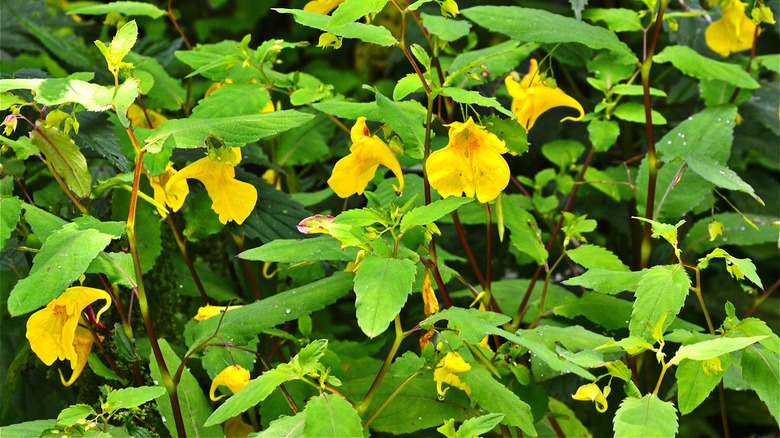How To Control Orange Jewelweed Before It Takes Over Your Garden
Foraged for its medicinal properties, especially by naturalists treating poison ivy or stinging nettle, orange jewelweed (Impatiens capensis) has become quite popular with homeowners. Its artful, full of nectar, bloody orange flowers splashed in red spots — highly attractive to hummingbirds and honeybees — further add to the annual's allure, coaxing gardeners to grow them in their yard. Given its easy adaptability to wet soil and shaded areas, many grow this "touch-me-not" to fill out their landscape's bare spots. But while jewelweed may make for a nice lawn addition, the decision to keep it can sometimes backfire, as the plant is a prolific spreader.
Often, orange jewelweed forms a dense carpet and competes with the native vegetation for nutrients and resources, harming them subsequently. Its voracious spreading can even crowd out other vegetative species, from plants you want to keep like daylilies to fellow invasive species like garlic mustard. So, it's essential to control its growth to ensure effective lawn care. Weeding them out usually works, but chemical treatment is necessary to take care of bigger populations.
Identifying orange jewelweed
Before we delve into control strategies, it's important to know how to spot orange jewelweed or spotted touch-me-not, lest you mistakenly remove other closely resembling impatiens you've planted. This summer annual grows to between 2 and 5 inches in height from a shallow taproot. It supports distinct, funnel-shaped, 1-inch long, orange-yellow flowers with orangish-red marks, although a few unspotted bloom-growing weeds exist. These two-lipped, five-petalled flowers taper, curl up at the end and connect to the main plant through a droopy stalk (pedicel). Besides its bright, showy flowers, the balsam-family plant also supports small, self-fertilizing, green blooms at the leaf's base.
Jewelweed's unscented, conspicuous flowers produce elongated, five-chambered seed capsules, each containing four or five seeds that burst the moment they're touched, explaining the reasoning behind their touch-me-not name. These nutty seeds are highly enjoyable for long-tongued beetles and birds but are toxic to humans. The unwanted intruder is also identifiable by its bluish-green, oval leaves with scalloped edges and a red-tinged, sap-containing stem.
Managing jewelweed's growth
After the orange jewelweed establishes itself in your yard, it's imperative to weed it out to avoid damaging your surrounding plants. As this ornamental isn't deeply rooted in the soil, you can simply pull it out using your hands. However, when removing from dry soil, ensure the entire root is out and the weed doesn't break midway. You may also use organic weed killers. If the weed has yet to produce seeds, crush it and put it aside to compost. But for seeded balsam, collect the capsules, bag them up, and dispose of them.
However, to control larger sections of spotted touch-me-not, use chemical weed control methods like herbicides. Ensure pollinators aren't active when opting for foliar applications. Moreover, as these annual woodland plants propagate by seeds that may spread over 4 to 6 feet when expelled from the pod, there's a risk they may remain dormant in the soil, necessitating follow-up management. Consider spreading mulch over the soil to restrict sun exposure and inhibit weed growth. Also, prevent re-invasion by planting more native varieties that can outcompete jewelweed.


